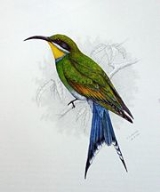
Swallow-tailed Bee-eater
Encyclopedia
The Swallow-tailed Bee-eater (Merops hirundineus) is a near passerine
bird
in the bee-eater
family
Meropidae. It breeds in savannah woodlands of sub-Saharan Africa
. It is partially migratory
, moving in response to rainfall patterns.
This species, like other bee-eaters, is a richly coloured, slender bird. Its colours and readily visible forked tail make this species unmistakable. It is mainly green with a yellow throat, blue gorget and black eye stripe and beak. It can reach a length of 20–22 cm, including the long forked green or blue feathers. Sexes are alike.
This is a species which prefers somewhat more wooded country than most bee-eaters. This attractive bird is readily approached. Just as the name suggests, bee-eaters predominantly eat insect
s, especially bee
s, wasp
s and hornet
s, which are caught in the air by sorties from an open perch. Swallowtail has a preference for honeybees.
These bee-eaters are nesting as pairs or in very small colonies
in sandy banks, or similar flat ground. They make a relatively long tunnel in which the 2 to 4 spherical, white eggs are laid. These birds also feed and roost communally.
Near passerine
Near passerine or higher land-bird assemblage are terms often given to arboreal birds or those most often believed to be related to the true passerines due to ecological similarities; the group corresponds to some extent with the Anomalogonatae of Garrod All near passerines are land birds...
bird
Bird
Birds are feathered, winged, bipedal, endothermic , egg-laying, vertebrate animals. Around 10,000 living species and 188 families makes them the most speciose class of tetrapod vertebrates. They inhabit ecosystems across the globe, from the Arctic to the Antarctic. Extant birds range in size from...
in the bee-eater
Bee-eater
The bee-eaters are a group of near-passerine birds in the family Meropidae. Most species are found in Africa and Asia but others occur in southern Europe, Australia, and New Guinea. They are characterised by richly coloured plumage, slender bodies, and usually elongated central tail feathers...
family
Family (biology)
In biological classification, family is* a taxonomic rank. Other well-known ranks are life, domain, kingdom, phylum, class, order, genus, and species, with family fitting between order and genus. As for the other well-known ranks, there is the option of an immediately lower rank, indicated by the...
Meropidae. It breeds in savannah woodlands of sub-Saharan Africa
Africa
Africa is the world's second largest and second most populous continent, after Asia. At about 30.2 million km² including adjacent islands, it covers 6% of the Earth's total surface area and 20.4% of the total land area...
. It is partially migratory
Bird migration
Bird migration is the regular seasonal journey undertaken by many species of birds. Bird movements include those made in response to changes in food availability, habitat or weather. Sometimes, journeys are not termed "true migration" because they are irregular or in only one direction...
, moving in response to rainfall patterns.
This species, like other bee-eaters, is a richly coloured, slender bird. Its colours and readily visible forked tail make this species unmistakable. It is mainly green with a yellow throat, blue gorget and black eye stripe and beak. It can reach a length of 20–22 cm, including the long forked green or blue feathers. Sexes are alike.
This is a species which prefers somewhat more wooded country than most bee-eaters. This attractive bird is readily approached. Just as the name suggests, bee-eaters predominantly eat insect
Insect
Insects are a class of living creatures within the arthropods that have a chitinous exoskeleton, a three-part body , three pairs of jointed legs, compound eyes, and two antennae...
s, especially bee
Bee
Bees are flying insects closely related to wasps and ants, and are known for their role in pollination and for producing honey and beeswax. Bees are a monophyletic lineage within the superfamily Apoidea, presently classified by the unranked taxon name Anthophila...
s, wasp
Wasp
The term wasp is typically defined as any insect of the order Hymenoptera and suborder Apocrita that is neither a bee nor an ant. Almost every pest insect species has at least one wasp species that preys upon it or parasitizes it, making wasps critically important in natural control of their...
s and hornet
Hornet
Hornets are the largest eusocial wasps; some species can reach up to in length. The true hornets make up the genus Vespa and are distinguished from other vespines by the width of the vertex , which is proportionally larger in Vespa and by the anteriorly rounded gasters .- Life cycle :In...
s, which are caught in the air by sorties from an open perch. Swallowtail has a preference for honeybees.
These bee-eaters are nesting as pairs or in very small colonies
Bird colony
A bird colony is a large congregation of individuals of one or more species of bird that nest or roost in close proximity at a particular location. Many kinds of birds are known to congregate in groups of varying size; a congregation of nesting birds is called a breeding colony...
in sandy banks, or similar flat ground. They make a relatively long tunnel in which the 2 to 4 spherical, white eggs are laid. These birds also feed and roost communally.

